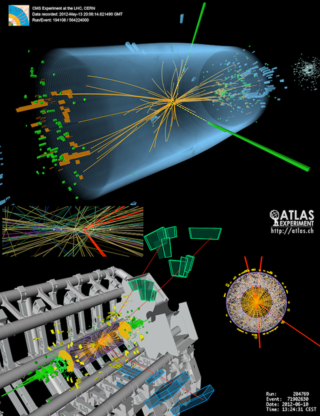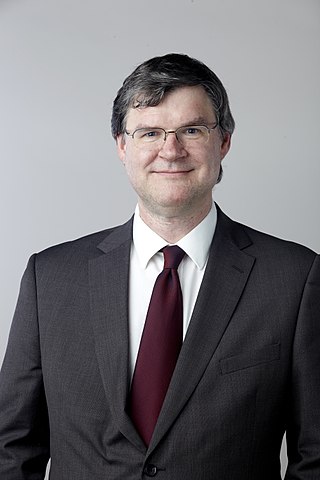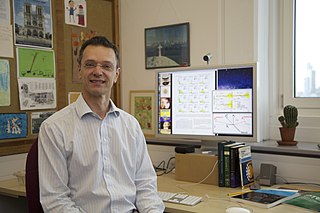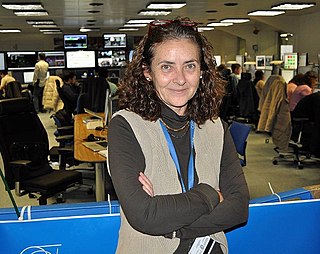Related Research Articles

In particle physics, proton decay is a hypothetical form of particle decay in which the proton decays into lighter subatomic particles, such as a neutral pion and a positron. The proton decay hypothesis was first formulated by Andrei Sakharov in 1967. Despite significant experimental effort, proton decay has never been observed. If it does decay via a positron, the proton's half-life is constrained to be at least 1.67×1034 years.

The Tevatron was a circular particle accelerator in the United States, at the Fermi National Accelerator Laboratory, east of Batavia, Illinois, and is the second highest energy particle collider ever built, after the Large Hadron Collider (LHC) of the European Organization for Nuclear Research (CERN) near Geneva, Switzerland. The Tevatron was a synchrotron that accelerated protons and antiprotons in a 6.28 km (3.90 mi) ring to energies of up to 1 TeV, hence its name. The Tevatron was completed in 1983 at a cost of $120 million and significant upgrade investments were made during its active years of 1983–2011.

ATLAS is the largest general-purpose particle detector experiment at the Large Hadron Collider (LHC), a particle accelerator at CERN in Switzerland. The experiment is designed to take advantage of the unprecedented energy available at the LHC and observe phenomena that involve highly massive particles which were not observable using earlier lower-energy accelerators. ATLAS was one of the two LHC experiments involved in the discovery of the Higgs boson in July 2012. It was also designed to search for evidence of theories of particle physics beyond the Standard Model.
In physics, mirror matter, also called shadow matter or Alice matter, is a hypothetical counterpart to ordinary matter.

The Large Electron–Positron Collider (LEP) was one of the largest particle accelerators ever constructed. It was built at CERN, a multi-national centre for research in nuclear and particle physics near Geneva, Switzerland.

The Belle experiment was a particle physics experiment conducted by the Belle Collaboration, an international collaboration of more than 400 physicists and engineers, at the High Energy Accelerator Research Organisation (KEK) in Tsukuba, Ibaraki Prefecture, Japan. The experiment ran from 1999 to 2010.

The DØ experiment was a worldwide collaboration of scientists conducting research on the fundamental nature of matter. DØ was one of two major experiments located at the Tevatron Collider at Fermilab in Batavia, Illinois. The Tevatron was the world's highest-energy accelerator from 1983 until 2009, when its energy was surpassed by the Large Hadron Collider. The DØ experiment stopped taking data in 2011, when the Tevatron shut down, but data analysis is still ongoing. The DØ detector is preserved in Fermilab's DØ Assembly Building as part of a historical exhibit for public tours.

Physics beyond the Standard Model (BSM) refers to the theoretical developments needed to explain the deficiencies of the Standard Model, such as the inability to explain the fundamental parameters of the standard model, the strong CP problem, neutrino oscillations, matter–antimatter asymmetry, and the nature of dark matter and dark energy. Another problem lies within the mathematical framework of the Standard Model itself: the Standard Model is inconsistent with that of general relativity, and one or both theories break down under certain conditions, such as spacetime singularities like the Big Bang and black hole event horizons.
In particle physics and string theory (M-theory), the ADD model, also known as the model with large extra dimensions (LED), is a model framework that attempts to solve the hierarchy problem. The model tries to explain this problem by postulating that our universe, with its four dimensions, exists on a membrane in a higher dimensional space. It is then suggested that the other forces of nature operate within this membrane and its four dimensions, while the hypothetical gravity-bearing particle graviton can propagate across the extra dimensions. This would explain why gravity is very weak compared to the other fundamental forces. The size of the dimensions in ADD is around the order of the TeV scale, which results in it being experimentally probeable by current colliders, unlike many exotic extra dimensional hypotheses that have the relevant size around the Planck scale.

The Higgs boson, sometimes called the Higgs particle, is an elementary particle in the Standard Model of particle physics produced by the quantum excitation of the Higgs field, one of the fields in particle physics theory. In the Standard Model, the Higgs particle is a massive scalar boson with zero spin, even (positive) parity, no electric charge, and no colour charge that couples to mass. It is also very unstable, decaying into other particles almost immediately upon generation.
In particle physics, W′ and Z′ bosons refer to hypothetical gauge bosons that arise from extensions of the electroweak symmetry of the Standard Model. They are named in analogy with the Standard Model W and Z bosons.

The search for the Higgs boson was a 40-year effort by physicists to prove the existence or non-existence of the Higgs boson, first theorised in the 1960s. The Higgs boson was the last unobserved fundamental particle in the Standard Model of particle physics, and its discovery was described as being the "ultimate verification" of the Standard Model. In March 2013, the Higgs boson was officially confirmed to exist.

David George Charlton is Professor of Particle Physics in the School of Physics and Astronomy at the University of Birmingham, UK. From 2013 to 2017, he served as Spokesperson of the ATLAS experiment at the Large Hadron Collider at CERN. Prior to becoming Spokesperson, he was Deputy Spokesperson for four years, and before that Physics Coordinator of ATLAS in the run-up to the start of collision data-taking.

Terence Richard Wyatt is a Professor in the School of Physics and Astronomy at the University of Manchester, UK.
Stephanie A. Majewski is an American physicist at the University of Oregon (UO) researching high energy particle physics at the CERN ATLAS experiment. She worked as a postdoctoral research associate at the Brookhaven National Laboratory prior to joining the faculty at UO in 2012. She was selected for the Early Career Research Program award of the U.S. Department of Energy (DOE), one of 35 scientists in all DOE-supported fields to receive this national honor in 2014.

Jonathan Mark Butterworth is a Professor of Physics at University College London (UCL) working on the ATLAS experiment at CERN's Large Hadron Collider (LHC). His popular science book Smashing Physics, which tells the story of the search for the Higgs boson, was published in 2014 and his newspaper column / blog Life and Physics is published by The Guardian.

Gavin Phillip Salam, is a theoretical particle physicist and a senior research fellow at All Souls College as well as a senior member of staff at CERN in Geneva. His research investigates the strong interaction of Quantum Chromodynamics (QCD), the theory of quarks and gluons.

]

Teresa Rodrigo Anoro was a Spanish scientist who worked in particle physics. She worked at CERN, Fermilab and the Instituto de Física de Cantabria and was professor at the University of Cantabria. Whilst at CERN, Rodrigo worked on the Compact Muon Solenoid and research for the Higgs boson.
Sinéad Farrington is a British particle physicist who works on the ATLAS experiment at the Large Hadron Collider.
References
- ↑ "Montana, U.S., Birth Records, 1897-1988" . www.ancestry.com. Retrieved May 27, 2022.
- 1 2 "Montana, U.S., Marriage Records, 1943-1988" . www.ancestry.com. August 15, 1985. Retrieved May 25, 2022.
- 1 2 3 "INSPIRE: David M. Strom". inspirehep.net. Retrieved May 25, 2022.
- ↑ Strom, D.M. (1986). "Measurement of the D0 lifetime". Dissertation: 197 – via University Microfilms.
- ↑ "David Strom's CV". pages.uoregon.edu. Retrieved May 25, 2022.
- ↑ "David M. Strom Professor, Department of Physics". old-physics.uoregon.edu. Retrieved May 25, 2022.
- ↑ "David Strom | College of Arts and Sciences". cas.uoregon.edu. Retrieved May 25, 2022.
- ↑ "University Senate Membership 2001-2002". pages.uoregon.edu. Retrieved May 25, 2022.
- 1 2 Tucker, Eric (Spring 2011). "Trigger Man". CASCADE, UO College of Arts and Sciences. Archived from the original on March 10, 2012. Retrieved May 25, 2022.
- ↑ Brau, Jim (Spring 2011). "Trigger Man - David Strom" (PDF). Physics News. Retrieved May 25, 2022.
- ↑ Adrian Cho (July 13, 2012). "Higgs Boson Makes Its Debut After Decades-Long Search". Science. 337 (6091): 141–143. Bibcode:2012Sci...337..141C. doi:10.1126/science.337.6091.141. PMID 22798574.
- ↑ "INSPIRE (ATLAS)". inspirehep.net. Retrieved May 27, 2022.
- ↑ "INSPIRE (BABAR)". inspirehep.net. Retrieved May 27, 2022.
- ↑ "INSPIRE (OPAL)". inspirehep.net. Retrieved May 27, 2022.
- ↑ "APS Fellow Archive". www.aps.org. Retrieved May 25, 2022.